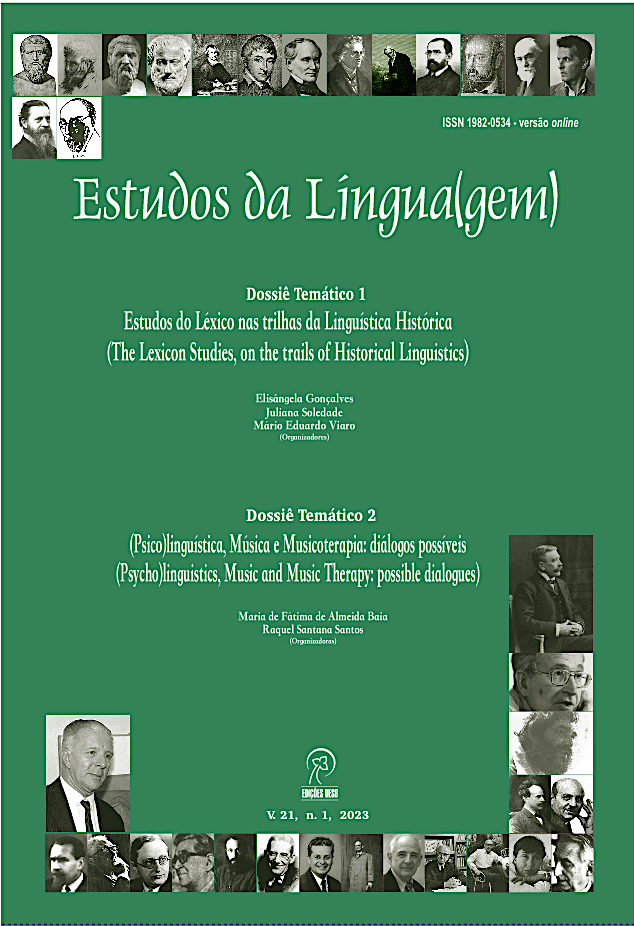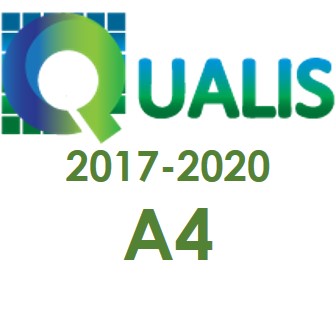Children's singing and traces of its development: complementarity between studies and theories
DOI:
https://doi.org/10.22481/el.v21i1.13374Keywords:
Children's singing; Musical cognition; Complementarity.Abstract
In order to deal with some aspects of children's singing and its relation to some cognitive aspects, we take these the following steps: (1) musical capacity is presented in three different views that are not mutually exclusive; (2) more recent studies on musical development are reviewed, with focus on singing and (3) finally, children spontaneous singing is addressed. Children's singing should be a promising study object for us to understand the relationship between the perception of musical environment and the individual's singing production in childhood; and how this perception and production reflect the musical environment and allow us to detect aspects of musical cognition.
Downloads
References
BIGAND, E., DELBÉ, C., POULIN-CHARRONNAT, B., LEMAN, M., TILLMANN, B. Empirical evidence for musical syntax processing? Computer simulations reveal the contribution of auditory short term memory. Frontiers in Systems Neurosciences, v. p. 94, jun. 2014. https://doi.org/10.3389/fnsys.2014.00094
BIGAND, E; POULIN-CHARRONNAT, B. Are we “experienced listeners”? A review of the musical capacities that do not depend on formal musical training. Cognition, v. 100, p. 100–130, 2006. doi: 10.1016/j.cognition.2005.11.007
CORBEIL, M., TREHUD, S. E.; PERETZ I. Speech vs singing: Infants choose happier sounds. Frontiers in Psychology, v. 4, p. 372, 2013.
COSTA GIOMI, E.; BENETTI, L. Through a baby’s ears: Musical interaction in a family community. International Journal of Community Music, v. 10, issue 3, p. 55-69. 2017. doi: 10.1386/ijcm.10.3.289_1
COSTA GIOMI, E.; BENETTI, L. Home musical environment and singing development in infancy. In: RUSSO, A.; ILARI, ILARI, B.; ANNABEL, J. COHEN. (eds.). The Routledge Companion to Interdisciplinary Studies in Singing Volume I: Development. 1ed. New York: Routledge Taylor & Francis Group, 2020. p. 189-199.
FALK, S.; TSANG, C. D. The role and functions of infant-directed singing in early development. In: RUSSO, A.; ILARI, ILARI, B.; ANNABEL, J. COHEN. (eds.). The Routledge Companion to Interdisciplinary Studies in Singing Volume I: Development. 1ed. New York: Routledge Taylor & Francis Group, 2020. p. 179-188.
FEDORENKO, E.; PATEL, A. D.; CASASANTO, D.; WINAWER, J.; GIBSON. E. Structural integration in language and music: Evidence for a shared system. Memory & Cognition, v. 37, p. 1-9, 2009.
FONSECA, M. B. P. A produção musical da criança na primeira infância. Monografia de Especialização em Educação Musical. Escola de Música da Universidade de Minas Gerais, 1986.
GUDMUNDSDOTTIR, H.; TREHUB, S. Adults’ recognize toddler' s song renditions. Psychology of Music, v. 46, p. 281-291, 2018.
KESSEN, W.; LEVINE, J.; WENDRICH, K. A. The imitation of pitch in infants. Infant Behavior and Development, v. 2, p. 93-99, 1979.
Patel A. D. Music, Language, and the Brain. Oxford: Oxford University Press, 2008.
LARGE, E. W. Neurodynamics of Music. In: JONES, M. R. s et al. (eds.) Music Perception, Springer Handbook of Auditory Research 36, 2010a. p. 201-226. doi 10.1007/978-1-4419-6114-3_7
LARGE, E. W. A dynamical systems approach to musical tonality. In: HUYS, R.; JIRSA, V. (Eds.), Nonlinear dynamics in human behavior. New York: Springer, 2010b. p. 193-211. doi: 10.1007/978-3-642-16262-6_9
LARGE, E.; KIM, J.; FLAIG, N. N.; BHARUCHA, J.; KRUMHANSL, C. L. A neurodynamic account of music tonality. Music Perception, Vol. 33, no. 3, p. 319-331, 2016. doi: 10.1525/mp. 2016.33.3.319
LERDAHL, F.; JACKENDOFF, R. A generative theory of tonal music. Cambridge: MIT Press, 1983.
MEHR, S. A.; SINGH, M.; KNOX, D.; KETTER, D. M.; PICKENS-JONES, D.; ATWOOD, S.; LUCAS, C.; JACOBY, N.; EGNER, A. A.; HOPKINS, E. J.; HOWARD, R. M.; HARTSHORNE, J. K.; JENNINGS, M. V.; SIMSON, J.; BAINBRIDGE, C. M.; PINKER, S.; O'DONNELL, T. J.; KRASNOW, M. N.; GLOWACKI, L. Universality and diversity in human song. Science, Vol 366, Issue 6468, 2019. Downloaded from http://science.sciencemag.org/ on November 28, 2019.
PAIVA, A.; MACHADO, A.; PARIZZI, B. O canto espontâneo como indicador do desenvolvimento musical de uma criança de quatro anos. Anais do 3º Nas Nuvens... Congresso de Música, 01 a 08 de dezembro de 2017, UFMG, UEMG e King’s Brazil Institute, p. 82-94, 2017. Acessado: 3º Nas Nuvens… Congresso de Música: Anais (2017) – Nas nuvens… Congresso de Música (ufmg.br)
PARIZZI, M. B. A música espontânea da criança como manifestação de seu estágio cognitivo. In: DOTTORI, M.; ILARI, B., SOUZA, R. Anais do 1º. Simpósio Internacional de Cognição e Artes Musicais. Curitiba: Deartes –UFPR, 2005. p. 379-385.
PARIZZI, M. B. O desenvolvimento da percepção do tempo em crianças de dois a seis anos: um estudo a partir do canto espontâneo. Tese (Doutorado em Ciências da Saúde). Faculdade de Medicina, Universidade Federal de Minas Gerais. Belo Horizonte, 2009.
PATEL, A. D. Language, music, and the brain: a resource-sharing framework. In: REBUSCHAT, P.; ROHRMEIER, M.; HAWKINS, J.; CROSS, I. (Eds.), Language and Music as Cognitive Systems. Oxford: Oxford University Press, 2012. p. 204-223.
RAPOSO DE MEDEIROS, B.; CABRAL, J. P.; MEIRELES, A.; BACETI, A. A comparative study of fundamental frequency stability between speech and singing. Speech Communication, v. 128, p. 15-23, 2021. https://doi.org/10.1016/j.specom.2021.02.003
RUSSO, F. A.; ILARI, B.; COHEN, A. J. Singing, development, interdisciplinarity and the biopsychosocial framework. In: RUSSO, A.; ILARI, ILARI, B.; ANNABEL, J. COHEN. (eds.) The Routledge Companion to Interdisciplinary Studies in Singing Volume I: Development. 1ed. New York: Routledge Taylor & Francis Group, 2020. p. 1-14.
STADLER ELMER, S. Human singing: Towards a developmental theory. Psymusichology: Music, Mind and Brain, v. 21, issue 1e 2, p. 13-30, 2012. Doi 10.1037/h0094001
STADLER ELMER, S. (2020). From canonical babbling to early singing and its relation to the beginnings of speech. In: RUSSO, A.; ILARI, ILARI, B.; ANNABEL, J. COHEN (eds.) The Routledge Companion to Interdisciplinary Studies in Singing Volume I: Development. 1ed. New York: Routledge Taylor & Francis Group, 2020. p. 25-38.
Sloboda, J. A. A mente musical: psicologia cognitiva da música. Trad. De Beatriz Ilari e Rodolfo Ilari. Londrina: EDUEL, 2008.
VAN DER SCHYFF, D.; SCHIAVO, A. WALTON, A., VELARDO, V. CHEMERO, A. Musical creativity and the embodied mind: Exploring the possibilities of 4E cognition and dynamical systems theory. Music & Science, v. 1, p. 1-18, 2018. doi.org/10.1177/2059204318792319
TREHUB, S.; RUSSO, F. A. (2020). Infant-directed singing from a dynamic multimodal perspective. In: : RUSSO, A.; ILARI, ILARI, B.; ANNABEL, J. COHEN (eds.) The Routledge Companion to Interdisciplinary Studies in Singing Volume I: Development. 1ed. New York: Routledge Taylor & Francis Group, 2020. p. 249-261.
WARLAUMONT, A. S.; RICHARDS, J. A.; GILKERSON, J.; OLLER, D. K. A social feedback loop for speech development and its reduction in autism. Psychological Science, v. 25, issue 7, p. 1314-1324, 2014. doi.org/10.1177/0956797614531023
Downloads
Published
How to Cite
Issue
Section
License

This work is licensed under a Creative Commons Attribution 4.0 International License.

Estudos da Língua(gem) is licensed under a Creative Commons Attribution 4.0 International License.
Authors who publish in the journal Estudos da Língua (gem) agree with the following terms:
The journal Estudos de Língua(gem) maintains the copyrights of the contributions published. These rights include the publication of the contribution and make its content available for free through the portal.







